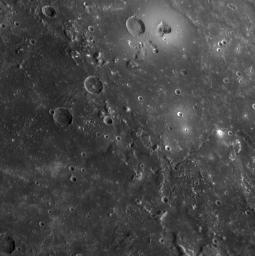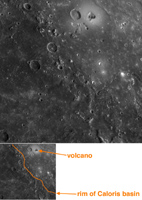
|
MESSENGER Discovers Volcanoes on Mercury
- Click the image above for a larger view
- Full-Res JPEG (1018 x 1022) (136.3 kB)
- Full-Res TIFF (1018 x 1022) (1.0 MB)
Caption:

Click on image for
larger annotated version
As reported in the July 4, 2008 issue of Science magazine , volcanoes have been discovered on Mercury's surface from images acquired during MESSENGER's first Mercury flyby. This image shows the largest feature identified as a volcano in the upper center of the scene. The volcano has a central kidney-shaped depression, which is the vent, and a broad smooth dome surrounding the vent. The volcano is located just inside the rim of the Caloris impact basin. The rim of the basin is marked with hills and mountains, as visible in this image. The role of volcanism in Mercury's history had been previously debated, but MESSENGER's discovery of the first identified volcanoes on Mercury's surface shows that volcanism was active in the distant past on the innermost planet.
Date Acquired:
January 14, 2008
Image Mission Elapsed Time (MET:
108826877
Instrument:
Narrow Angle Camera (NAC) of the Mercury Dual Imaging System (MDIS)
Resolution:
270 meters/pixel (0.17 miles/pixel)
Scale:
This image is about 270 kilometers across (170 miles)
Spacecraft Altitude:
10,500 kilometers (6,500 miles)
Background Info:
These images are from MESSENGER, a NASA Discovery mission to conduct the first orbital study of the innermost planet, Mercury. For information regarding the use of images, see the MESSENGER image use policy .
Cataloging Keywords:
| Name | Value | Additional Values |
|---|---|---|
| Target | Mercury | |
| System | ||
| Target Type | Planet | |
| Mission | MESSENGER | |
| Instrument Host | MESSENGER | |
| Host Type | Orbiter | |
| Instrument | Mercury Dual Imaging System (MDIS) | |
| Detector | Narrow Angle Camera (NAC) | |
| Extra Keywords | Grayscale, Impact, Mountain, Volcano | |
| Acquisition Date | ||
| Release Date | 2008-07-11 | |
| Date in Caption | 2008-01-14 | 2008-07-04 |
| Image Credit | NASA/Johns Hopkins University Applied Physics Laboratory/Carnegie Institution of Washington | |
| Source | photojournal.jpl.nasa.gov/catalog/PIA10942 | |
| Identifier | PIA10942 | |
